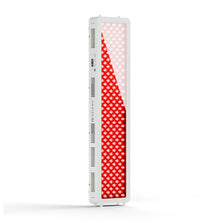Hiking is a physically strenuous sport that needs vitality, stamina, and determination. Although it has its magnificent rewards, such as captivating views, fresh air, and being in sync with nature, it does put a lot of pressure on the body. Long walks, steep climbs, and uncertain terrain can result in muscle fatigue, stress on joints, and injuries.
Red light therapy (RLT), a healing technique that involves exposure to low-wavelength red light, has become popular among athletes and outdoor people alike. Red light therapy can be an excellent boost for injured hikers on the mend: It can speed up tissue healing, lessen post-exercise soreness, and help prevent injuries. This article will look at some of the physical challenges of hiking and how red light therapy can help address these challenges.

Understanding the Physical Demands and Challenges Faced by Hikers
The Impact of Long Trails and Steep Terrain on Muscle Fatigue and Joint Stress
Walking over long periods, especially through rough terrain with steep climbs and declines, places a heavy toll on our bodies. The strain caused by repeated motion can result in an accumulation of tension in your muscles and joints, which causes pain and sometimes even injury. Walking down steep trails takes a toll on the knees while marching uphill taxes the quads, calves, and hip flexors. Eventually, this kind of wear and tear can cause pain that persists from day to day and mobility problems.
In addition, wearing a loaded backpack also increases the load on the spine and lower extremities, which will also aggravate muscle fatigue. Extended treks also lead to micro-tears in muscle fibers, which lead to a phenomenon called delayed onset muscle soreness (DOMS) [1]. Managing these physical stresses is essential to maintaining a regular hiking routine without lasting consequences.
The Importance of Effective Recovery and Injury Prevention for Sustained Hiking Performance
For serious hikers, recovery is every bit as important as endurance. When appropriate recovery practices are not applied, significant muscle damage in addition to inflammation can result in chronic pain, diminished mobility, and even chronic injuries such as tendonitis or stress fractures. Red light therapy is one of the effective recovery techniques that can help minimize muscle strain, reduce inflammation, and speed up the recovery process. However, by taking care of post-hike recovery and injury prevention, hikers can hike longer without being forced off the trails by achy joints or stiffness.
How Red Light Therapy Addresses Key Hiking-Related Physical Issues?
Enhancing Muscle Recovery and Reducing Inflammation for Faster Post-Hike Healing
Red light therapy promotes the process by which low-wavelength light is delivered to the skin and deeper tissues, thereby stimulating cellular repair and reducing inflammation. For hikers, that means faster recovery, better mobility, and a better time on the trail.
The biggest advantage of red light therapy is that it can speed up the healing of muscles. It works by revving up mitochondria — the energy factory of cells — to generate extra ATP (adenosine triphosphate), the fuel for tissue repair.
For hikers, this means [2]:
- Faster Recovery: Soreness recovers quicker, meaning hikers get to resume the trail sooner.
- Reduced Inflammation: Red light therapy reduces oxidative stress that causes muscle stiffness and soreness.
- Enhanced Strength with Continued Use: With gradual use, you may see improved muscular endurance and strength
Promoting Joint Health and Reducing Pain, Allowing for More Comfortable and Frequent Hikes
Red light therapy keeps joints in optimal condition so that hikers can feel confident taking on dense trails with ease. Hiking is hard on the joints, especially the knees and ankles. Red light therapy protects your joints by the following [3]:
- Relieving Pain and Stiffness: Research indicates that red light therapy can reduce joint pain by lowering inflammatory markers.
- Encourage Cartilage Restoration: Using it consistently will help slow cartilage degeneration, leading to minimized chances of chronic joint problems.
- Improved Flexibility: The reduction of stiffness allows the hikers or walkers to move more freely and with less effort.
Specific Performance Benefits of Red Light Therapy for Hiking Enthusiasts
Increased Endurance and Reduced Muscle Soreness, Enabling Longer and More Challenging Hikes
Endurance is one of the most important aspects of hiking, particularly for those taking on multi-day walks or high-altitude trails. Research suggests that exposure to red light increases muscle endurance through oxidative damage reduction and improved mitochondrial function. That means hikers can go farther, feel less fatigued, and can push themselves harder.
RLT also offers the benefit of decreased post-hike muscle soreness so that hikers can maintain consistency in their training and adventure schedules. More downtime between hikes means more chances to explore unfamiliar trails without discomfort slowing down.

Improved Circulation and Reduced Swelling Lead to Faster Recovery and Reduced Discomfort
Proper circulation is crucial for recovery and injury prevention in all muscles. This results in better blood circulation and helps for rejuvenating the recovering muscle tissues in the body. This improved circulation also aids in reducing swelling, which can happen after prolonged hiking, especially in the feet and ankles.
By reducing inflammation and improving lymphatic drainage, RLT reduces the incidence of plantar fasciitis or Achilles tendonitis—two common hiking ailments. This provides a more comfortable hike and a lower chance of swelling and pain.
Practical Tips for Integrating Red Light Therapy into Hiking Routines
Recommendations for lightweight, durable red light tools suited for backpacking
Integrating red light therapy with a hiking lifestyle doesn’t need to be complicated. With a choice of lightweight, portable devices available all the way through multi-day hikes.
The best red light therapy device should be:
- Portable: Choose compact, rechargeable, or battery-operated options.
- Durable: As hiking conditions can be tough, it should be shock and water-resistant.
- Power Output: Wavelengths between 630-850 nm are optimal for deep tissue penetration.
A few recommended options include:
- Handheld red-light therapy wands.
- Light therapy wraps for knees, ankles, or shoulders.
- Small LED panels that may be used in campsites for recovery sessions.
Guidelines for pre-hike preparation, post-hike recovery, and adapting sessions to trail difficulty
This schedule will ensure you get the best from your red light therapy:
Pre-Hike Preparation:
- You should do red light therapy for 15-30 minutes on major muscle groups (feet, knees, lower back) before work.
- Pay attention to regions that are often hurt or sore.
Post-Hike Recovery:
- Immediately after you finish hiking, you want to apply a red light therapy device to sore muscles and or joints for 20-30 min each.
- Apply it before hitting the sack to encourage muscle recovery overnight.
Adapting to Trail Difficulty:
- Shorter hikes: Leverage red light therapy pre and post-as fast recovery agent.
- Long or hard hikes: Increase the number of post-hike treatment sessions to lower soreness and recovery time for the next day’s hike.
Conclusion
Hiking is a most rewarding activity but it is tough on the body. Incorporating red light therapy into a hiking routine can aid in recovery, minimize pain, and increase endurance and, therefore, performance. Whether you are gearing up for a big trek, healing from a multi-day excursion, or facing chronic joint dysfunction, red light therapy offers a research-supported method of improving hiking performance.
Now, thanks to lightweight and portable red light therapy devices, hikers can take this effective recovery tool with them wherever they go and have it on every trail to ensure they are sore and pain-free. If you're serious about getting better at hiking, you may want to give red light therapy a try to help you recover for longer, less painful hikes.
References
- Knott, J W. “Causes of injuries in the mountains: a review of worldwide reports into accidents in mountaineering.” Journal of the Royal Army Medical Corps vol. 157,1 (2011): 92-9. doi:10.1136/jramc-157-01-16
- DE Oliveira, Marcelo F, et al. “Low-intensity LASER and LED (photobiomodulation therapy) for pain control of the most common musculoskeletal conditions.” European Journal of Physical and Rehabilitation Medicine vol. 58,2 (2022): 282-289. doi:10.23736/S1973-9087.21.07236-1
- Coracini, Camila Amaral, et al. “The use of LED therapy to treat synovial joint disorders: scoping review.” Lasers in medical science vol. 37,2 (2022): 701-721. doi:10.1007/s10103-021-03372-4















 Small
Small

 Moderate
Moderate

 Moderate
Moderate

 Moderate
Moderate

 Full
Full



